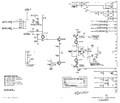3B1: Difference between revisions
m (Add 050-0582-00 documentation) |
m (→top: clean up, replaced: title=Tektronix → manufacturer=Tektronix |series=560-series scopes |type=, {{Plugin Sidebar 2 → {{Plugin Sidebar, series=560-series scopes → designers=) |
||
| Line 1: | Line 1: | ||
{{Plugin Sidebar | {{Plugin Sidebar | | ||
manufacturer=Tektronix |series=560-series scopes |type= 3B1 | | |||
summary=10 MHz time base | | summary=10 MHz time base | | ||
image=3b1 front.jpg | | image=3b1 front.jpg | | ||
| Line 6: | Line 6: | ||
introduced=1962 | | introduced=1962 | | ||
discontinued=(?) | | discontinued=(?) | | ||
designers= | | |||
manuals= | manuals= | ||
* [http://w140.com/tek_3b1.pdf Tektronix 3B1 Manual (PDF)] | * [http://w140.com/tek_3b1.pdf Tektronix 3B1 Manual (PDF)] | ||
| Line 16: | Line 16: | ||
The calibrated sweep rates go from 1 s/Div to 500 ns/Div. | The calibrated sweep rates go from 1 s/Div to 500 ns/Div. | ||
There is a switch that enables 5 × horizontal magnification, | There is a switch that enables 5 × horizontal magnification, which makes the fastest sweep 100 ns/Div. | ||
which makes the fastest sweep 100 ns/Div. | |||
The 3B1 has a delayed sweep and a regular sweep. | The 3B1 has a delayed sweep and a regular sweep. | ||
Revision as of 12:30, 14 August 2021
The Tektronix 3B1 is a time-base plug-in introduced in 1962 for 560-series scopes. 10 MHz is is the maximum trigger frequency. The calibrated sweep rates go from 1 s/Div to 500 ns/Div.
There is a switch that enables 5 × horizontal magnification, which makes the fastest sweep 100 ns/Div. The 3B1 has a delayed sweep and a regular sweep.
Key Specifications
- please add
Internals
The 3B1 uses vacuum tubes, bipolar junction transistors, and tunnel diodes.
The trigger input goes through the int/ext switch and then the ac/dc coupling switch, and then a 7895 cathode follower. The output of the cathode follower drives one base of a 2N2207 PNP differential amplifier which has a tunnel diode in the collector load. The tunnel diode generates pulses when it switches back and forth between its two stable voltages, which are capacitively coupled to a 2N2501 NPN common emitter amplifier.
The delay pickoff circuit is a 6DJ8 differential amplifier that compares the sweep ramp voltage with a knob-controlled DC voltage which determines the point where the delayed trigger starts. The DC voltage is made by a ZZ1000 80 V reference passed through a potentiometer-variable voltage divider.
When the sweep ramp exceeds the control voltage, a 2.2 mA tunnel diode in the plate load of the differential amplifier switches state.
Pictures
-
Front
-
Left
-
Right
-
Bottom
-
Top
-
In 1965 Catalog
-
Normal trigger circuit
-
Delayed trigger circuit
-
Delay pickoff circuit
-
Normal sweep circuit
-
Delayed sweep circuit
-
Horizontal amp circuit










